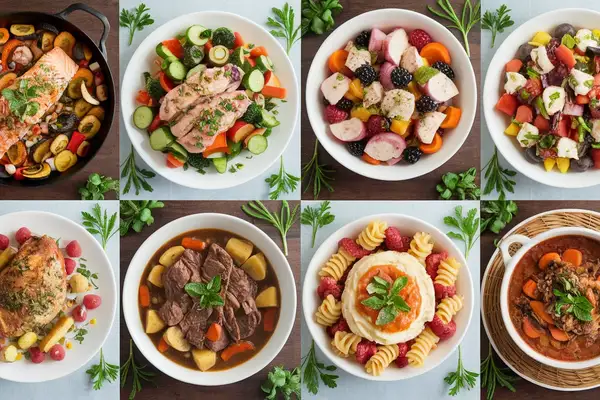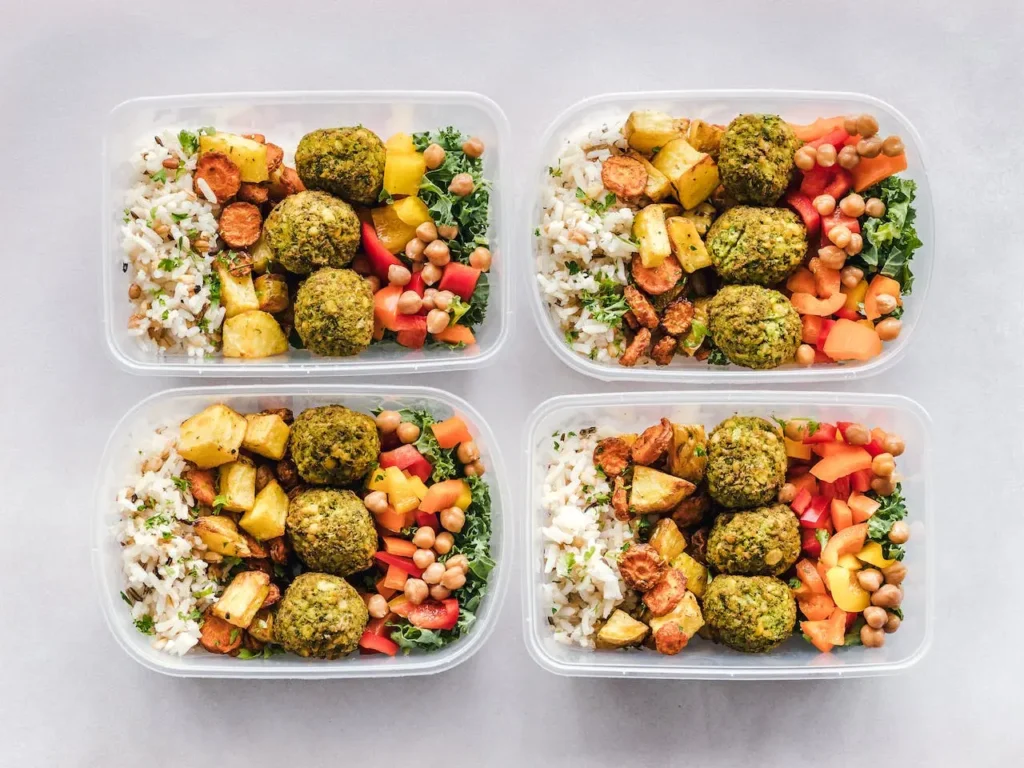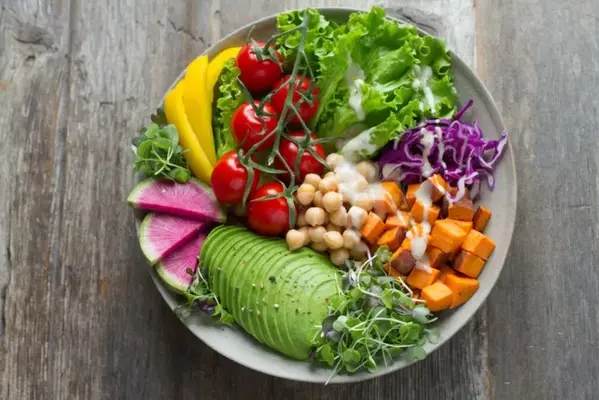Free 7-Day Diabetic Meal Plan For Beginners
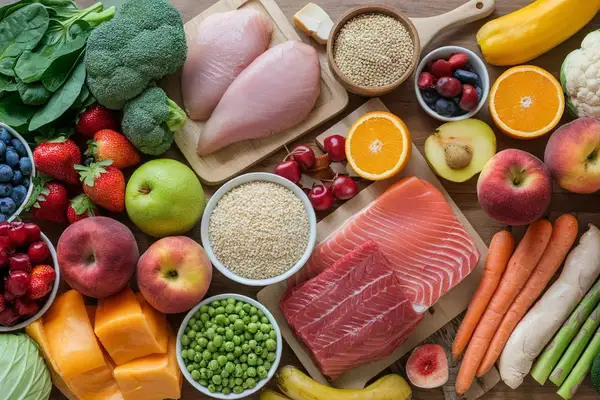
This post may contain affiliate links, meaning I may earn a commission if you make a purchase, at no extra cost to you. I only recommend products I trust. Thank you for your support.
Managing diabetes doesn’t mean you have to give up delicious food.
With the right diabetic meal plan, you can enjoy a variety of tasty diabetic recipes and meals while keeping your blood sugar levels in check.
Whether you’re newly diagnosed or looking for new diabetic meal ideas, this 7-day diabetic meal plan will guide you through a week of balanced eating, designed to keep your energy up and your A1C levels down.
What Is a Diabetic Diet?
A diabetic diet is an eating approach focussing on balanced nutrition that helps control blood sugar (glucose) levels.
A diabetic diet plan focuses on eating the healthiest foods in moderate amounts and sticking to regular mealtimes.
The key is to choose nutrient-dense foods that provide fiber, lean protein, and healthy fats while minimizing added sugars and refined carbohydrates.
Key elements of a diabetic diet include:
- Complex Carbohydrates: Choose whole grains, fruits, and vegetables.
- Lean Proteins: Opt for fish, poultry, beans, and legumes.
- Healthy Fats: Include nuts, seeds, and olive oil.
- Fiber-Rich Foods: These help slow down the absorption of sugar, thereby preventing blood sugar spikes.
Diabetic Diet Food List
Creating a detailed diabetic diet food list involves focusing on foods that help manage blood sugar levels and foods that lower A1C.
Foods that lower A1C levels are crucial for managing diabetes effectively. The A1C test measures your average blood sugar levels over the past two to three months, so eating foods that help control blood sugar can significantly impact this measure.
Here are the best foods for diabetes together with foods that lower A1C levels:
1. Vegetables
- Spinach
- Kale
- Broccoli
- Cauliflower
- Brussels sprouts
- Cabbage
- Zucchini
- Asparagus
- Bell peppers
- Sweet potatoes (In moderation)
- Squash (In moderation)
- Peas (In moderation)
2. Fruits
- Berries (strawberries, blueberries, raspberries)
- Apples
- Oranges
- Lemons
- Grapes
- Pears
- Peaches
- Cherries
3. Whole Grains
- Quinoa
- Brown rice
- Oats
- Whole wheat pasta
- Barley
- Millet
4. Proteins
- Chicken breast
- Turkey
- Lean cuts of beef
- Salmon
- Tuna
- Mackerel
- Trout
- Lentils
- Chickpeas
- Black beans
- Tofu
- Tempeh
5. Dairy
- Low-fat milk
- Greek yogurt
- Cottage cheese
6. Nuts and Seeds
- Almonds
- Walnuts
- Chia seeds
- Flaxseeds
- Pumpkin seeds
7. Healthy Fats
- Olive oil
- Avocado
- Nuts such as almonds, walnuts, flaxseeds, chia seeds (in moderation)
8. Beverages
- Water
- Herbal teas
- Coffee (without added sugar)
9. Snacks
- Fresh vegetables with hummus
- A small handful of nuts
- Greek yogurt with berries
10. Condiments
- Cinnamon
- Apple Cider Vinegar
- Garlic
- Onions
- Turmeric
Worst Foods for Diabetics
When managing diabetes, it’s crucial to avoid or limit foods that can cause spikes in blood sugar levels.
Here are some of the worst foods for diabetics that are known to cause spikes in blood sugar levels:
1. Sugary Foods
- Candy
- Cookies
- Cakes
- Pastries
- Soda
- Sweetened coffee drinks
- Fruit juices with added sugar
2. Refined Carbohydrates
- White bread
- White rice
- Pasta made from refined flour
- Breakfast cereals with added sugars
3. Fried Foods
- French fries
- Fried chicken
- Doughnuts
- Other deep-fried snacks
4. High-Fat Meats
- Processed meats (bacon, sausages)
- Fatty cuts of beef or pork
5. Full-Fat Dairy Products
- Full-fat milk
- Cream
- Full-fat cheese
6. Trans Fats
- Margarine
- Packaged snacks with hydrogenated oils
- Some baked goods
7. High-Sodium Foods
- Canned soups
- Processed snacks
- Fast food
8. Alcoholic Beverages
- Sweet wines
- Cocktails with sugary mixers
9. Packaged Snacks
- Potato chips
- Pretzels
- Crackers with refined flour
7-Day Diabetic Meal Plan (Diabetic Menu)
This 7-day diabetic meal plan provides a variety of tasty and easy diabetic recipes that not only satisfy your taste buds but also help manage blood sugar levels.
Whether you’re new to managing diabetes or looking to improve your diet, these diabetic friendly recipes feature foods that are known to help lower A1C levels, making it an excellent resource for beginners and anyone aiming to maintain better blood sugar control.
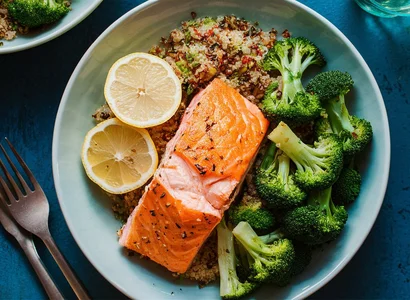
Day 1
Breakfast:
- Oatmeal with Berries: Cooked oats topped with fresh blueberries and a sprinkle of cinnamon. (1/2 cup oats, 1/4 cup blueberries, 1/2 tsp cinnamon)
- Green Tea: A soothing cup to kickstart your metabolism. (1 cup)
Lunch:
- Grilled Chicken Salad: Mixed greens, cherry tomatoes, cucumber, and grilled chicken breast with balsamic vinaigrette. (2 cups mixed greens, 1/2 cup cherry tomatoes, 1/2 cucumber, 4 oz grilled chicken breast, 2 tbsp balsamic vinaigrette)
- Whole Grain Roll: A small whole grain roll on the side. (1 small roll, approximately 1 oz)
Dinner:
- Baked Salmon: Served with quinoa and steamed broccoli. (4 oz salmon, 1/2 cup cooked quinoa, 1 cup steamed broccoli)
- Mixed Berry Salad: A refreshing mix of strawberries, raspberries, and a hint of mint. (1/2 cup strawberries, 1/4 cup raspberries, 1 tsp fresh mint)
Snacks:
- Almonds: A handful of almonds for a quick energy boost. (1 oz, approximately 23 almonds)
- Greek Yogurt: Plain Greek yogurt with a dash of vanilla extract. (1/2 cup Greek yogurt, 1/4 tsp vanilla extract)
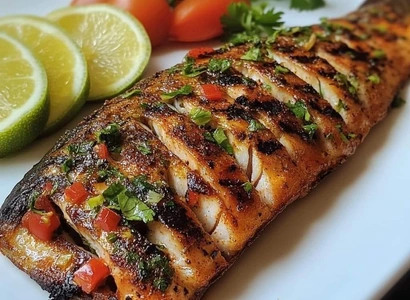
Day 2
Breakfast:
- Scrambled Eggs with Spinach: Eggs scrambled with fresh spinach and a slice of whole-grain toast. (2 eggs, 1/2 cup spinach, 1 slice whole-grain toast)
- Black Coffee: Enjoy it plain to avoid added sugars. (1 cup)
Lunch:
- Grilled Trout: Trout fillet seasoned and grilled, served with steamed vegetables. (4 oz trout fillet, 1 tsp olive oil, 1 cup mixed steamed vegetables like broccoli, carrots, and zucchini)
- Mixed Greens Salad: A side salad of mixed greens with a light vinaigrette. (2 cups mixed greens, 2 tbsp vinaigrette)
Dinner:
- Stir-Fried Tofu and Vegetables: Tofu with bell peppers, snap peas, and soy sauce over brown rice. (4 oz tofu, 1/2 cup bell peppers, 1/2 cup snap peas, 1 tbsp soy sauce, 1/2 cup cooked brown rice)
- Cucumber Salad: Sliced cucumber with a squeeze of lemon. (1/2 cucumber, 1 tsp lemon juice)
Snacks:
- Apple Slices with Peanut Butter: A classic combination for a sweet and savory snack. (1 medium apple, 1 tbsp peanut butter)
- Cheese Cubes: A few cubes of low-fat cheese. (1 oz low-fat cheese)

Day 3
Breakfast:
- Greek Yogurt Parfait: Layered with granola and sliced almonds. (1/2 cup Greek yogurt, 1/4 cup granola, 1 tbsp sliced almonds)
- Herbal Tea: A calming herbal tea of your choice. (1 cup)
Lunch:
- Quinoa and Black Bean Bowl: Quinoa mixed with black beans, corn, and diced tomatoes. (1/2 cup cooked quinoa, 1/2 cup black beans, 1/4 cup corn, 1/4 cup diced tomatoes)
- Lime Wedge: A wedge of lime to squeeze over the bowl. (1 lime wedge)
Dinner:
- Herb-Crusted Chicken: Baked chicken breast with herbs, served with roasted sweet potatoes. (4 oz chicken breast, 1/2 cup roasted sweet potatoes)
- Steamed Asparagus: A side of asparagus for added fiber. (1 cup steamed asparagus)
Snacks:
- Celery Sticks with Hummus: A crunchy and creamy combination. (1 cup celery sticks, 2 tbsp hummus)
- Mixed Nuts: A small handful of mixed nuts. (1 oz mixed nuts)

Day 4
Breakfast:
- Smoothie Bowl: Blend spinach, banana, and almond milk, topped with chia seeds. (1 cup spinach, 1 small banana, 1/2 cup almond milk, 1 tbsp chia seeds)
- Green Tea: Another cup to keep you refreshed. (1 cup)
Lunch:
- Lentil Soup: A hearty bowl of lentil soup with carrots and celery. (1 cup lentil soup, including 1/4 cup lentils, 1/4 cup carrots, 1/4 cup celery)
- Whole Grain Crackers: A few crackers for dipping. (4-5 crackers, approximately 1 oz)
Dinner:
- Grilled Shrimp Skewers: Marinated shrimp grilled to perfection, served with a side of couscous. (4 oz shrimp, 1/2 cup cooked couscous)
- Tomato and Basil Salad: Fresh tomatoes with basil and a drizzle of olive oil. (1/2 cup cherry tomatoes, 1 tbsp fresh basil, 1 tsp olive oil)
Snacks:
- Rice Cakes with Almond Butter: A light and satisfying snack. (2 rice cakes, 1 tbsp almond butter)
- Berry Mix: A mix of your favorite berries. (1/2 cup mixed berries)
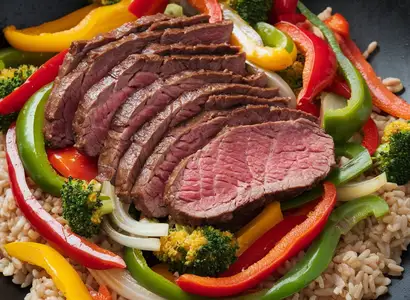
Day 5
Breakfast:
- Whole Grain Pancakes: Topped with fresh strawberries and a dollop of Greek yogurt. (2 small pancakes, 1/4 cup strawberries, 2 tbsp Greek yogurt)
- Coffee: Enjoy a cup, but keep it sugar-free. (1 cup)
Lunch:
- Chickpea Salad: Chickpeas with diced cucumbers, tomatoes, and a lemon-tahini dressing. (1/2 cup chickpeas, 1/4 cup diced cucumbers, 1/4 cup diced tomatoes, 1 tbsp lemon-tahini dressing)
- Pita Bread: A small piece of whole wheat pita. (1/2 pita bread, approximately 1 oz)
Dinner:
- Beef Stir-Fry: Lean beef strips with broccoli and bell peppers over brown rice. (4 oz lean beef, 1/2 cup broccoli, 1/2 cup bell peppers, 1/2 cup cooked brown rice)
- Mango Salsa: A side of mango salsa for a tropical twist. (1/4 cup diced mango, 1 tsp lime juice, 1 tbsp chopped cilantro)
Snacks:
- Popcorn: Air-popped popcorn with a sprinkle of nutritional yeast. (3 cups air-popped popcorn, 1 tbsp nutritional yeast)
- Cottage Cheese: Low-fat cottage cheese with pineapple chunks. (1/2 cup low-fat cottage cheese, 1/4 cup pineapple chunks)
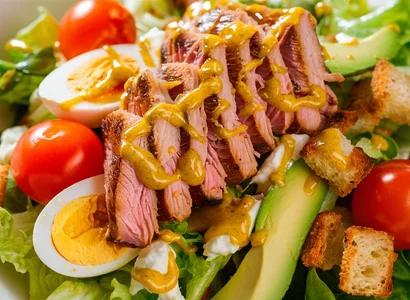
Day 6
Breakfast:
- Avocado Toast: Whole grain toast topped with mashed avocado and a poached egg. (1 slice whole grain toast, 1/2 avocado, 1 poached egg)
- Herbal Tea: A relaxing cup to start your day. (1 cup)
Lunch:
- Tuna Nicoise Salad: A classic salad with tuna, hard-boiled eggs, green beans, olives, and tomatoes, dressed with olive oil and lemon juice. (3 oz tuna, 1 hard-boiled egg, 1/2 cup steamed green beans, 5 olives, 1 tbsp olive oil, 1 tsp lemon juice)
- Cherry Tomatoes: A handful of cherry tomatoes on the side. (1/2 cup cherry tomatoes)
Dinner:
- Roasted Chicken Thighs: Seasoned with rosemary, served with mashed cauliflower. (2 small chicken thighs, 1/2 tsp rosemary, 1/2 cup mashed cauliflower)
- Green Beans: Steamed green beans for a fiber boost. (1 cup steamed green beans)
Snacks:
- Dark Chocolate: A small piece of dark chocolate for a sweet treat. (1 oz dark chocolate)
- Sliced Peppers: Bell pepper slices with hummus. (1/2 cup bell pepper slices, 2 tbsp hummus)

Day 7
Breakfast:
- Chia Seed Pudding: Chia seeds soaked in almond milk, topped with kiwi slices. (2 tbsp chia seeds, 1/2 cup almond milk, 1/2 kiwi sliced)
- Black Coffee: A simple cup to accompany your breakfast. (1 cup)
Lunch:
- Veggie Burger: A whole grain bun with a veggie patty, lettuce, and tomato. (1 whole grain bun, 1 veggie patty, 1/2 cup lettuce, 2 slices tomato)
- Sweet Potato Fries: Oven-baked sweet potato fries. (1/2 medium sweet potato, cut into fries and baked)
Dinner:
- Baked Cod: Cod fillet with lemon and herbs, served with barley and spinach. (4 oz cod fillet, 1 tsp lemon juice, 1/2 cup cooked barley, 1 cup spinach)
- Mixed Greens: A side salad with your favorite greens and vinaigrette. (2 cups mixed greens, 2 tbsp vinaigrette)
Snacks:
- Trail Mix: Homemade trail mix with nuts and dried fruit. (1 oz nuts, 1/4 cup dried fruit)
- Carrot and Celery Sticks: With a side of ranch dressing for dipping. (1/2 cup carrot sticks, 1/2 cup celery sticks, 2 tbsp ranch dressing)
Benefits of a Diabetic Diet Plan
Following a meal plan for diabetes is pivotal for diabetic patients, as it serves as a cornerstone for both immediate and long-term health benefits.
Here are the benefits of following a diabetic diet meal plan:
- Blood Sugar Control: A well-structured diabetic diet plan helps regulate blood sugar levels, reducing the risk of spikes and crashes that can be harmful over time.
- Weight Management: Following a diabetic meal plan can help with weight loss or maintenance, which is crucial for improving insulin sensitivity and overall health.
- Reduced Risk of Complications: Consistently managing blood sugar through diet lowers the risk of diabetes-related complications such as heart disease, kidney disease, and nerve issues.
- Improved Energy Levels: By eating balanced meals that provide steady energy, a diabetic diet can help you avoid the fatigue that often comes with blood sugar fluctuations.
- Better Nutrient Intake: A meal plan for diabetes emphasizes nutrient-dense foods like vegetables, lean proteins, and whole grains, ensuring that you get essential vitamins and minerals.
- Lower A1C Levels: Sticking to a diabetic meal plan can help reduce your A1C levels, which is a key marker of long-term blood sugar control.
- Heart Health: Many diabetic diets are rich in heart-healthy foods that are low in saturated fats and cholesterol, reducing the risk of cardiovascular diseases.
- Better Digestive Health: High-fiber foods included in a diabetic meal plan promote good digestion and help prevent constipation and other digestive issues.
Diabetic Meal Plan Tips
For a successful diabetic meal plan, here are some of the tips for you to follow:
- Focus on Complex Carbohydrates: Choose whole grains like brown rice, quinoa, whole wheat, oats, and barley. These carbs have a lower glycemic index and are digested more slowly, leading to gradual increases in blood sugar levels.
- Balance Your Plate: Aim to fill half your plate with non-starchy vegetables, one quarter with lean proteins, and one-quarter with whole grains or starchy vegetables. This balance helps keep blood sugar levels stable.
- Monitor Portion Sizes: Carbohydrate portion control is crucial for managing blood sugar. Using tools like carb counting or the plate method can help ensure balanced meals.
- Increase Fiber Consumption: Foods high in fiber, such as vegetables, fruits, legumes, and whole grains, help slow down the absorption of sugar, thereby preventing blood sugar spikes.
- Include Healthy Fats: Incorporate healthy fats from sources like avocados, nuts, seeds, and olive oil. These fats can help you feel full and satisfied without spiking blood sugar.
- Eat Regularly: Eating at regular intervals throughout the day can prevent blood sugar spikes and dips. Try to have three balanced meals and one or two healthy snacks if needed.
- Stay Hydrated: Drink plenty of water throughout the day. Avoid sugary drinks, which can cause blood sugar to rise rapidly.
- Choose Low-Glycemic Foods: Opt for foods with a low glycemic index (GI) like berries, whole grains, and most vegetables. These foods release sugar more slowly into your bloodstream.
- Prep Ahead: Prepare your meals and snacks in advance to avoid making unhealthy choices when you’re short on time or hungry. Meal planning can also help you stick to your diet.
- Monitor Your Blood Sugar: Regularly check your blood sugar levels to see how different foods affect you. This can help you make adjustments to your diabetic meal plan as needed.
- Read Labels: Check for hidden sugars and unhealthy fats in packaged foods.
Resources
When it comes to diabetic meal planning, there are numerous resources available to provide guidance, inspiration, and support.
Here are five reputable resources worth exploring:
- American Diabetes Association (ADA): The ADA offers a wealth of information, recipes, and diabetic meal planning tools on its website.
- Diabetic Living: Diabetic Living magazine provides a wide range of recipes, diabetic meal plans, and articles specifically tailored to individuals with diabetes.
- EatRight.org: The Academy of Nutrition and Dietetics website, EatRight.org, provides evidence-based information on diabetes management, including diabetic meal planning tips and recipes.
- National Institute of Diabetes and Digestive and Kidney Diseases (NIDDK): The NIDDK is a part of the National Institutes of Health and offers comprehensive resources on diabetes management.
- Diabetes Strong: Diabetes Strong is a great platform that provides fitness and nutrition advice for individuals with diabetes. They help with diabetic meal planning tips and healthy diabetic recipes.
- Eat This, Not That!: Eat This, Not That! is a popular platform that focuses on making healthier food choices. They have a specific section dedicated to diabetic recipes and diabetic meal ideas.
Conclusion
Living with diabetes doesn’t mean you have to give up delicious food. This 7-day diabetic meal plan is designed to be flexible, tasty, and supportive of your health goals.
By focusing on balanced meals that include the best foods for diabetes, you’ll find it easier to manage your blood sugar while enjoying a variety of flavors and textures.
Whether you’re cooking for yourself or your loved ones, this diabetic diet plan can be a foundation for healthier eating habits that benefit everyone at the table.
Remember to consult with healthcare professionals and utilize the available resources to create personalized meal plans.
- How to reverse prediabetes quickly
- 7-day meal plan for prediabetes
- 7-day meal plan for gestational diabetes
- 7-Day meal plan for kidney disease
- Crohn’s Disease Diet Plan: What to Eat and What to Avoid
- 7-Day Meal Plan for Pancreatitis Recovery
- Top 10 nephrologists near me
- 7 day meal plan for seniors
- Time saving and easy meal prep ideas
- 7-day renal diet plan
- 21-day Fix meal plan
- 7-day clean eating meal plan
- 7-day endomorph diet plan
- 7-day metabolic confusion diet meal plan
- 7-day alkaline diet meal plan for beginners
- 7-day meal plan for pancreatitis
- 7-day gastritis meal plan
FAQs
What food can diabetics eat freely?
Diabetics can freely enjoy non-starchy vegetables like spinach, broccoli, and peppers. These foods are low in calories and carbohydrates, making them ideal for blood sugar management.
Is banana good for diabetes?
Bananas can be part of a diabetic diet when eaten in moderation. They are high in carbs and natural sugars, so pairing them with a source of protein or fat (like nuts or yogurt) can help prevent blood sugar spikes.
Is coffee good for diabetics?
Coffee, when consumed without added sugars or high-fat creamers, can be part of a diabetic diet plan. It may even offer some protective benefits against type 2 diabetes.
How to bring blood sugar down?
To lower blood sugar, try physical activity, stay hydrated, and choose foods with a low glycemic index. Foods high in fiber, such as vegetables, whole grains, and legumes, can help slow the absorption of sugar.
What is the best diet for a diabetic person?
The best diet for a diabetic person is one that focuses on whole, unprocessed foods. This includes plenty of vegetables, lean proteins, whole grains, and healthy fats.
Disclaimer:
The information provided in this diabetic meal plan is for educational and informational purposes only and is not intended as medical advice.
Always consult with a healthcare provider or a registered dietitian before making any changes to your diet, especially if you have diabetes or any other medical condition.
